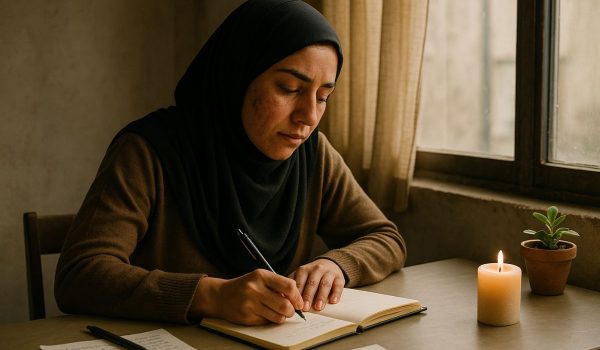Pain can take many forms. Some wounds are visible, others stay hidden. But even when words are hard to speak, writing can offer a way through. For people who have lived through conflict, displacement, or deep personal loss, creative writing becomes more than an outlet—it becomes a lifeline.
Across Palestinian communities and other spaces shaped by trauma, young and old writers alike are turning to the page. Through poetry, short stories, journals, or letters, they begin to name their experiences. They take what feels chaotic or overwhelming and begin to shape it into something that can be seen, shared, and understood.
Why This Topic Matters
This article explores how creative writing helps individuals process trauma. It looks at how writing builds personal agency, offers emotional release, and strengthens identity in the face of pain.
You’ll read about how communities use writing workshops to support healing, how the act of telling one’s story can challenge silence, and why creative expression remains one of the most powerful tools for resilience.
Naming What Was Once Unspoken
Trauma often lives in silence. It can make people feel alone, ashamed, or disconnected from others. Creative writing helps break that silence. It allows the writer to put words to what happened—on their terms, at their pace.
There is no pressure to be perfect. The point is not grammar or form. It’s expression. A single sentence can carry a weight that has lived unspoken for years. A metaphor can describe fear, hope, or memory in ways that feel safer than direct language.
By writing down their truth, people begin to see it outside of themselves. They gain distance. They can shape it, look at it, and begin to understand it in a new way.
Creating Safety on the Page
One of the most healing parts of creative writing is that it offers control. In a world where trauma often means a loss of power, the act of writing returns agency. The writer decides what to say, how to say it, and whether or not to share it.
This control builds trust. It creates a space where fear doesn’t have to win. Where emotion can be held without judgment. For many, writing becomes a quiet companion. A place to go when nothing else feels safe.
Even when shared with others, writing can be edited, revised, or kept anonymous. That flexibility makes it especially helpful for people still learning how to speak their truth.
Storytelling as a Path to Belonging
Trauma can isolate. It can make people feel like no one understands what they’ve been through. But when someone reads a story that echoes their own pain, they feel seen. They remember that they are not alone.
In group writing workshops, participants often hear lines that mirror their own stories. A line from one person becomes a spark for another. Sharing becomes less scary and more empowering. These workshops often become small communities, where care grows with every page.
Telling a story out loud is powerful—but writing it down means it can live on. It can be returned to, revisited, and reimagined. It gives the storyteller a place in history.
Writing Across Generations
Creative writing also helps pass stories between generations. Children can write letters to grandparents. Elders can share memories through poetry. Families who have lived through displacement can record what was lost—and what was carried forward.
These stories matter. They preserve identity. They honor experience. They let younger generations understand what came before and why it matters now.
Even fictional stories, inspired by real events, can carry deep truth. They offer emotional safety while still telling what needs to be told. They let writers reimagine what healing could look like.
From Personal Healing to Public Voice
Some writers begin in private journals. Others publish essays, perform spoken word, or create books. All of these forms are valid. All of them offer healing. But when shared publicly, writing also becomes a form of advocacy.
A personal story can move hearts more than statistics. It can help outsiders understand injustice in ways that reports cannot. It can build bridges between communities and across cultures.
Palestinian writers, for example, have long used poetry and prose to speak to the world. Their work carries personal pain and collective struggle. It reminds readers that behind every headline is a human life with a story worth hearing.
Teaching Writing as a Healing Tool
Across schools, community centers, and refugee camps, writing programs are offering space for expression. These workshops don’t try to fix trauma. They offer a place to begin healing.
Participants are encouraged to write freely, without judgment. Prompts may include a memory, a hope, or a single image. Feedback focuses on connection, not correction. The goal is to listen deeply and support each voice.
Facilitators don’t need to be professional writers. They need to be good listeners. They need to create space for quiet, for choice, and for reflection. Writing becomes a gentle doorway into healing work that may otherwise feel too hard to start.
Words That Stay
Not all writing has to lead to big moments. Sometimes a single poem, tucked into a notebook, is enough. Sometimes a journal entry read by a close friend is all someone needs to feel heard.
But over time, the words add up. They become a map of where someone has been—and how far they’ve come. They show strength, even in moments of deep vulnerability.
For people living through ongoing stress or conflict, writing is a way to hold on. To themselves, to their community, and to the belief that healing is possible.
A Different Kind of Power
Trauma takes away control. Creative writing gives some of that back. It doesn’t erase pain, but it allows space for growth, truth, and connection.
Writing helps people reclaim their voice. It invites others to listen. And it reminds everyone—writers and readers alike—that every story has value. Every voice deserves space. And every step toward healing counts.

